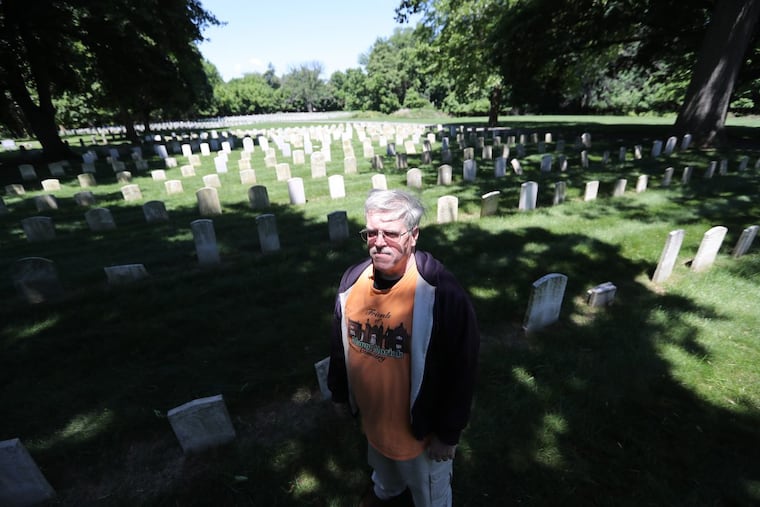Researchers identify 718 nameless veterans buried at Mount Moriah Cemetery
A corps of volunteers at Mount Moriah Cemetery spent four years identifying veterans buried in the graveyard's Naval Plot. They now wait for the Veterans Administration to replace the indecipherable headstones with new ones, engraved with the names of the fallen.

Hundreds of U.S. Navy officers and sailors have lain for decades under the anonymity of inscrutable gravestones at Mount Moriah, a 19th century cemetery whose 380 acres span Southwest Philadelphia and Yeadon Borough. For many of the dead, time wore away their names. For others, long-ago conflicts stole not only their lives but their identities, rendering them "unknown" — though not, as it turns out, for eternity.
A corps of 250 volunteers invested nearly a thousand hours over the course of four years to identify 718 veterans buried in the Naval Plot, one of two sections within Mount Moriah that are part of the National Cemetery Administration and reserved for those who served in the military and their families.
"These men and women had a name when they went into the service, whether they fought a war or stayed home, whether they served a day or 30 years. They had a name," said Paulette Rhone, board president of the Friends of Mount Moriah Cemetery, a nonprofit dedicated to preserving the graveyard.
Now, nearly two years after the veterans identification project ended, cemetery officials and relatives of those interred there are urging the federal government to replace the old stones with new ones, engraved with the names recovered by the volunteers.
National Cemetery Administration officials say such an effort is in the works, but that it will take time. "We want to make sure we've done our due diligence and insure accuracy," said Gregory Whitney, director of the Washington Crossing National Cemetery, who oversees Mount Moriah's military plots for the Veterans Administration.
The agency's historians are researching burial records and other historic information about the graves. When that task is completed, Whitney said, the VA will replace the stones. Each will reflect the marker's original design, which differs depending on the era in which the veteran died, and could incorporate information combed from cemetery archives by the volunteers, who included members of the Friends group and students from area universities, Whitney said he expects replacement to start next spring.
The veterans identification project got underway in 2012 following an inquiry from the Medal of Honor Historical Society of the United States. The education and research organization was looking for the burial location of a John Smith who received the medal for heroism while serving on the USS Richmond during the Civil War, and had tracked his grave to Mount Moriah.
Samuel Ricks, a board member of the Friends group, tried to help them, but he was stymied. By then, the cemetery's records — 300 boxes of everything from perpetual care contracts to financial documents — were packed away at a storage facility, a situation prompted by the cemetery's whirlwind rescue in 2011.
In April of that year, Mount Moriah, once the resting place of Betsy Ross's remains, was closed, having been abandoned by the widow of the last known member of the Mount Moriah Cemetery Association, which owned the property. The graveyard was placed in receivership and the Mount Moriah Cemetery Preservation Corp. was created to organize its records and restore its overgrown grounds. That included the two sections administered by the Veterans Administration: the Naval Plot, where 2,120 Marine and Navy vets are buried, and the Soldiers' Lot, the resting place of 400 Army vets.
Once the receivership was finalized, volunteers began weekly visits to the storage facility — and later, to the City Archives in University City, where the records were moved — to photograph every cemetery document in the 300 boxes.
But by the summer of 2013, no registry had been found with the names and locations of those buried in the cemetery. Unsure that such a list was even in the boxes, but determined to attach a name to every grave, Ricks settled on an even more labor-intensive strategy. He recruited 200 students from Villanova, Drexel, and Temple Universities to walk the rows of the Naval Plot and record the information on its more than 2,000 stones. As they did, they located John Smith's nearly illegible stone. They also found 717 markers that were worn to illegibility, cracked, toppled, moss-covered or inscribed "Unknown."
Ricks entered every stone's piece of information, however small and incomplete, on a computer spreadsheet.
Then, in December 2014, one of the 300 storage boxes gave up Mount Moriah's secrets. Inside were seven large binders containing the elusive burial records. Ricks now had the names and gravesites that he could cross-reference with his own survey. Among the hundreds confirmed were Commodores Jesse Duncan Elliott, a Medal of Honor recipient and hero of the War of 1812, and Peter Turner, commander of the U.S. Naval Asylum in Philadelphia from 1863 to 1868. Elliott was in a grave marked "Unknown." Turner had no stone at all.
Scott Anderson, a house painter from Yardley, had been looking for the grave of his great-great-great-grandfather, Elliott, for 10 years. Several years ago, online research led him to Mount Moriah, and Ricks led him to Elliott's grave, near a monument depicting a Navy anchor.
Elliott's and Turner's graves were identified earlier than others in the project, so their stones are due to be replaced "shortly," Whitney said.
Anderson can't wait.
"We took some pictures" of the grave, he said. "They're supposed to be putting up a new marker. We're looking forward to it, whenever it happens."